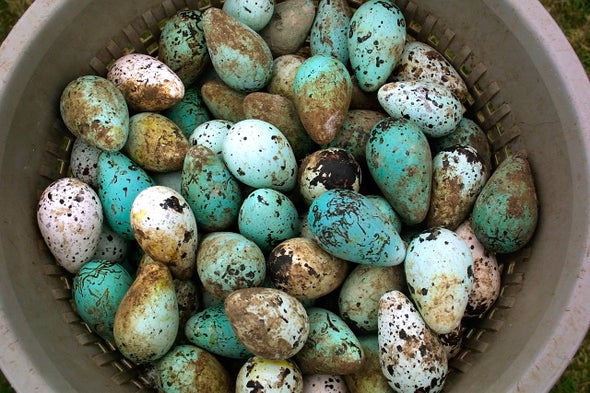(单词翻译:单击)
听力文本
This is Scientific American's 60-second Science, I'm Christopher Intagliata.
Most supermarket eggs look pretty boring. Plain white chicken eggs; brown ones if you're lucky. However:
"There's a couple breeds that have blue eggs. And you can buy them at Whole Foods, actually."
Daniel Hanley, an evolutionary ecologist at Long Island University—who has a very specific reason for caring about the color of his eggs.
"I'm always thinking about eggs. It's one of the tools I use to understand ecological and evolutionary processes. So I study the function and evolution of natural colors. And the main system I use are birds eggs."
Unlike white supermarket eggs, most bird eggs are colored various shades of bluish-green or brown due to two characteristic pigments birds produce. And by examining the egg colors of 634 species from around the world, Hanley and his colleagues found a curious pattern.

"In the northern climates, where it's the coolest, eggs are darker and browner. And those colors should give some type of adaptive benefit to those parents to be off of their eggs for a slightly longer period of time."
Darker eggs, in theory, would absorb more of the scarce sunlight in the Arctic, keeping the eggs warmer and allowing their parents to spend more time away from the nest, looking for food. And indeed, when Hanley's team left 66 differently colored duck, quail and chicken eggs in the sun, they found that the darker the eggs, the more slowly they lost their heat.
The details and a world map of egg colors are in the journal Nature Ecology & Evolution.
And if you're wondering then "Are dark brown chicken eggs from some ancestral arctic chicken?"
"No, no, no, no."
They just come from a different breed of hen. One that maybe prefers to buck the trend.
Thanks for listening for Scientific American's 60-second Science. I'm Christopher Intagliata.
参考译文
这里是科学美国人——60秒科学系列,我是克里斯托弗·因塔格里塔。
大多数超市售卖的鸡蛋看起来都很乏味。基本都是普通的白色鸡蛋,如果幸运的话,你会看到棕色鸡蛋。然而:
“有几种鸡能下蓝色鸡蛋。实际上你可以在全食超市买到。”
长岛大学的进化生态学家丹尼尔·汉利说到,他因为一个非常特殊的原因而关心鸡蛋颜色。
“我总是在思考鸟蛋。这是我用来理解生态和进化过程的工具之一。我研究自然颜色的功能和演变。使用的主要方法就是鸟蛋。”
与超市里的白色鸡蛋不同,大多数鸟蛋都呈现不同程度的蓝绿色或棕色,这是因为鸟类会产生两种特有色素。在研究了全球各地634种鸟蛋之后,汉利及其同事发现了一个不寻常的模式。
“在北方气候最寒冷的地方,鸟蛋颜色会更深更棕。这些颜色应该让父母获得了某种适应优势,使其离开鸟蛋的时间可以稍微长一些。”
理论上,颜色更深的鸟蛋会吸收更多北极地区稀少的阳光,让鸟蛋保温,使父母得以更长时间地离开巢穴去觅食。的确,当汉利的团队将66个不同颜色的鸭蛋、鹌鹑蛋和鸡蛋放在阳光下时,他们发现鸟蛋的颜色越深,散热速度越慢。
研究详情以及全球鸟蛋颜色图刊登在《自然·生态与进化》期刊上。
如果你想知道,“深棕色的鸡蛋是古代北极鸡生的吗?”
“不,不不不。”
它们只是来自不同品种的母鸡。一种可能更喜欢逆潮流而动的母鸡。
谢谢大家收听科学美国人——60秒科学。我是克里斯托弗·因塔利亚塔。
译文为可可英语翻译,未经授权请勿转载!
重点讲解
重点讲解:
1. care about 关心;在乎;在意;
He genuinely cares about his employees.
他真诚地关心他的雇员。
2. due to 由于;因为;
They arrived late due to a motorway hold-up.
他们因高速公路交通堵塞迟到了。
3. in theory 从理论上说;照理说;
In theory, these machines should last for ten years or more.
从理论上讲,这些机器应能用十年以上。
4. buck the trend 抵抗;抵制;反抗;
While other newspapers are losing circulation, we are bucking the trend.
当其他报纸的发行量越来越少时,我们却逆势而进。


